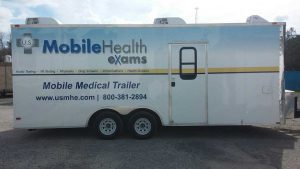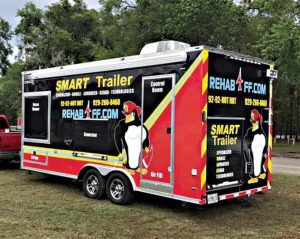Mobile pharmacy units can serve patients as standalone operational units or integrated into an existing facility. With this flexibility, healthcare providers can use the device to offer patient outreach as well as pharmacy services. These mobile cleanrooms also offer a faster alternative that integrates a customizable and preconfigured solution by supplying a turnkey cleanroom.
The need for portable and customizable cleanrooms can be quickly deployed in the event of a natural disaster like storms and earthquakes or to bring healthcare services to at-risk communities. If you considering an investment in a mobile medical unit like this, don’t hesitate to reach out to us by email or phone. We have 20+ years experience in the industry and offer complimentary design blue prints for all clients.
- What Can You Do With A Mobile Compounding Pharmacy/Clean Room Trailer?
- What Equipment Can Be Installed In A Mobile Pharmacy?
- What Rooms Could Be Built Into A Mobile Pharmacy Or Clean Room?
What Can You Do With A Mobile Compounding Pharmacy/Clean Room Trailer?

Mobile medical trailer built by M&R Specialty Trailers and Trucks.
A mobile pharmacy trailer delivers pharmaceutical services anywhere you need to go. A mobile pharmacy provides the most efficient in providing immediate response and on-site access to important medications, together with aiding foreign and charitable medical missions. Mobile pharmacy units can be relocated quickly and efficiently with a truck.
Controlling contamination is crucial for sustaining effective production practices in the pharmaceutical sectors. The mitigation of contamination must be ensured and efficiently considered. Therefore, healthcare providers frequently choose mobile clean rooms in order to maintain the greatest level of care in a sanitized environment.
Regarding its characteristics and purpose, the transportable clean room is identical. It is a site where the degree of contamination in the specified area is controlled. With changeable humidity and temperature control, such mobile clean rooms become the reconfigurable rooms that are synonymous with clean rooms for basic comfort cooling. Utilizing clean room apparatus, backup power, lighting, water, and other support structures, the mobile clean room satisfies the required level of cleanliness.
At M&R Specialty Trailers and Trucks, we are able to manufacture a mobile medical unit that fits your exact specifications and needs. Give us a call at 904-397-0246 and we can create a custom plan for your unit.
What Equipment Can Be Installed In A Mobile Pharmacy?
You can install any equipment required into a mobile pharmacy trailer provided there’s enough space. Here’s a list of some of the equipment frequently installed in a mobile pharmacy trailer.
1. Hand-Operated Tablet Machine – Utilizing compression machinery, tablets are created by compressing the granules. With many improvements being made to tablet compression machines, it is currently possible to create more than half a million tablets every hour. Hydraulic pressure is the primary guiding concept of the tablet compression machine. The static fluid receives this pressure with no reduction. Through static fluid, any applied pressure from the outside is distributed evenly in all directions.
2. Continuous Hot Extraction Equipment – Continuous hot percolation, also known as Soxhlet Extraction or Soxhelation, is a process used to extract crude drugs by the action of hot menstruum for a significant amount of time when the active components of the drug are not easily soluble in the solvent or challenging to dislodge from the drug’s cells. The stationary oils from seeds and alkaloids from the drug are collected using benzene, chloroform, petroleum, and ether. The equipment used for this process has three parts, namely: Soxhlet extractor, flask, and a condenser where the solvent’s vapors are condensed back into the solvent.
3. Disintegrator – The Disintegrator is a machine for coarse grinding that can be used in a wide range of industries, including the food industry to handle fruits, vegetables, and fish cuts of meat, along with chemicals, plastics (resins), pharmaceuticals, and other materials. Depending on the requirements, it can either do dry milling or wet milling.
4. Conical Percolator – Most percolators have a lid drain cock that is mounted on a stainless steel sieve that is supported by a three-legged pedestal. Stainless steel material makes up the conical percolator. These percolators are frequently employed in laboratory studies carried out in organizational and research institutions for research and teaching functions.
5. Ball Mill – Ball mills come in two varieties: grate type and over-fall type due to various methods of material discharge. The ball mill is a crucial piece of machinery for grinding materials and is utilized in a variety of powder-making production lines, including those for glass ceramics, cement, silicate sand, new-style building materials, refractory materials, fertilizer, and ore dressing of ferrous and non-ferrous metals. Different ores and materials can be ground using a ball mill, either dry or wet. Ball mill with skeleton-like design, two hoppers, and horizontal cylindrical turning gear that is operated by an outer gear.
6. Friability Tester – The purpose of the friability tester is to assess the impact hardness and abrasion rate of tablets. This device serves as a precise measuring tool for tablet obtrusion strength. Two clear acrylic drums with a 25.1 rpm rotational speed are included in the apparatus. A transparent acrylic drum is rotated by a strong, high-quality motor that runs at a steady pace, and it is positioned in a painted metal casing with a chemical-resistant powder coating.
7. Pfizer Type Hardness Tester – The tool provides precise, repeatable outcomes. Compared to other traditional hardness testers, it operates significantly more quickly. The braking force of a convenient, robust, direct dial, reading type tablet hardness tester, acting as a pair of plaits, is produced in a single grip.
8. Capsule Filling Machine – The loading plate can be lifted by the operator without worrying that they would break the capsules thanks to the handle locking system. Heavy cast iron serves as the main body, while heavily plated brass or stainless steel serves as the material for all contact points. A portable, hand-operated device for filling two-part hard gelatin capsules.
9. Distillation Unit For Distilled Water – It is simple to use and secure to operate. Distilled water has a number of qualities that are unequaled by comparable stills and is built for dependable continuous operation. A high-efficiency condenser keeps the distilled output cool and abundant. The still produces 4 Liters per hour of distilled water with an input power of 3KW from a chromium-plated heater placed in a horizontal glass boiler.
10. Water Deionization Apparatus – In order for deionization systems to function, hydrogen (a positive molecule) and hydroxyl (a negative molecule) are used in place of the negative and positive water molecules, respectively. As a result of the organic materials being eliminated during filtering, the water’s quality is improved and scale deposits are not allowed to form. Deionized water is one of the most frequently used solutions in manufacturing facilities and factories because of this.
11. Ampoule Filling Sealing Device – To meet the demands of the pharmaceutical filling industry, ampoule filling and sealing machines, also known as ampoule fillers, execute filling and sealing. Powered by electricity, the syringe’s piston can be adjusted to fit the desired amount of liquid. The burner for sealing completes the work. Before, during, and after gas flushing is an option. During gas loading and flushing, the ampoule gas centers.
What Rooms Could Be Built Into A Mobile Pharmacy Or Clean Room?

Mobile rehab trailer built by M&R Specialty Trailers and Trucks.
In order to comply with new regulations, numerous hospital pharmacies are undertaking extensive modifications. Even so, they must proceed uninterrupted with the crucial medicine preparation. The hospital may continue its independent, on-site sterile medicine compounding activities while it is still being built out thanks to mobile pharmacy compounding cleanrooms.
It would be essential to have solutions that integrate a customizable and readymade approach by producing a ready-to-use, complete cleanroom that just necessitates utility hookups upon setup, regardless of whether you are undertaking a cleanroom refurbishment or constructing a new cleanroom. Here are certain rooms that can be built into a mobile pharmacy compounding cleanroom.
Hazardous Negative Pressure Compounding Room
A negative pressure room works by removing more air than is delivered over a predetermined amount of time. Air naturally flows from a high-pressure zone to a low-pressure area. Aerosols are externally exhausted from the negative room by means of an airtight containment structure and a precisely calibrated HVAC system, while clean, conditioned air is also introduced for ventilation and temperature management.
A low-pressure confinement space with air that has been expelled outside is necessary for a negative pressure cleanroom. Toxic substances, foul odors, and dangerous gasses are prevented from spreading to adjacent areas by a slight negative pressure. During entry, exit, or passthrough, any potentially dangerous liquids or aerosols are prevented from escaping thanks to adjacent high-pressure chambers. Work surfaces’ airborne contaminants are directly evacuated to the outside by negative exhausts located inside storage cabinets and workstations.
Hazardous Gowning Room
To effectively control contamination in cleanrooms, the right furniture, and gowning supplies must be used. An area outside of the cleanroom where operators can change into and out of street clothing is known as a gowning room, also known as an ante-room. The space is split into a sanitary and a dirty side, and it is designed for sequential processes that require fewer steps.
Depending on the surrounding environment, cleanroom gowning calls for various furnishings and amenities. Typically, it serves as a staging area for cleaning, washing hands, storing, and donning clothing like shoe covers, hair nets (bouffants), gloves, coats, or coveralls. The journey from uncontrolled common areas to adequately pressured cleanrooms is supported by gowning rooms in pharmaceutical, medical, and biotech applications. The gowning room design for hazardous or sterile operations must satisfy USP, CGMP, or FDA requirements for aseptic workflow, sterilization processes, and operator safety.
Compounding Aseptic Containment Isolator (CACI)
Often referred to as the hazardous unpack/storage room, the compounding aseptic containment isolator (CACI) is a special kind of CAI created for the compounding of sterile potentially dangerous drugs. The building’s exterior is ventilated. Contrary to a CAI, which is only used for non-hazardous pharmaceuticals, a CACI is the only device that can mix hazardous medications.
Anteroom (Non-Hazardous Gowning Room)
Personnel hand washing, garbing operations, and other tasks that produce high particle levels are carried out in an anteroom. The ante-room serves as a passageway between the facility’s unclassified area and the buffer room.
In order to restrict any airborne hazardous drugs (HD), USP 800 mandates that ante-rooms must induce inbound air migration with the same sanitation categorized air into the negative buffer room. A hand-washing basin must be situated at least one meter away from the HD barrier room’s entrance in order to comply with the USP 800’s standard for ante-rooms and prevent contamination of the negative pressure HD buffer room.
Positive Pressure Non-Hazardous Compounding Room
Facilities with pressurized non-hazardous compounding and holding spaces are necessary for cleanroom designs. In the event of a compromised barrier, positive pressure guarantees that the environment will remain sterile. Compounding TPN (Total Parenteral Nutrition), antibiotic shots, eye drops, infusion, injections, salves, oils, and other products is possible in positive pressure rooms. No less than 30 ACH is required for a direct compounding area with an ISO Class 5 laminar flow equipment (air changes per hour).
There are numerous vendors that provide a range of provisional cleanroom choices, a number of which are essentially on wheels and can be stationed just outside the facility. Other possible solutions are modular cleanrooms that sit firmly on the ground and are assembled off-site and installed for a variety of configurations and setups before being delivered to an institution. Call us at 904-397-0246 to discuss the requirements for your custom build.

Leave A Comment